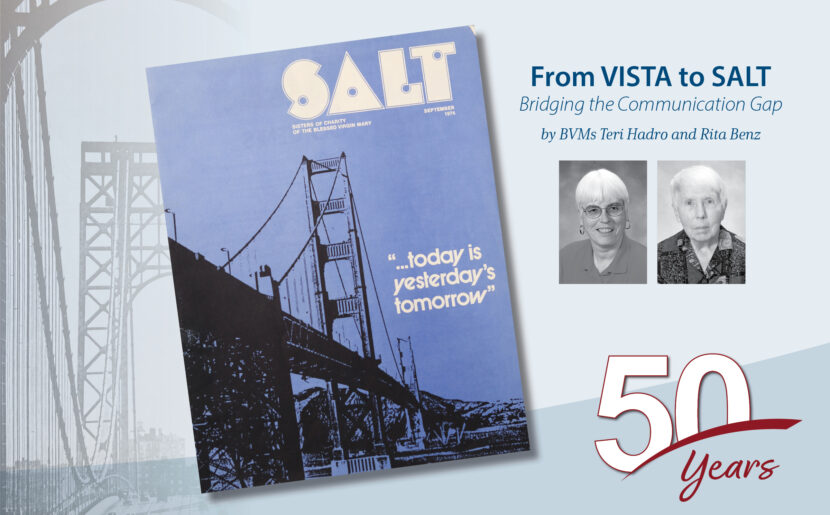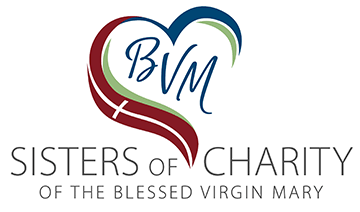From Vista to Salt: Bridging the Communication Gap

Published in Salt magazine, September, 1974
by Teri Hadro, BVM and Rita Benz, BVM
From VISTA of the fifties and sixties to SALT of the mid-seventies is a move from a view of the times to a savoring of life. It’s more than that, it’s a look at BVM involvement in current social, religious, political issues. SALT’s aim is to report—yes, but more—to influence, to change, to add zest, to enliven. SALT: a periodical with a new format and focus.
Rich in tradition, SALT emerges from a long line of BVM publications: OUR HERALD (first issued in April 1913), special interest publications such as ALUMNI NEWS and EDUCATION NEWS, and finally VISTA which told the BVM story for 12 historic and eventful years.
The rationale for the demise of VISTA (September 1969), given in the final issue, seemed best explained in an anecdote from DYNAMICS OF CHANGE. “We have all had the experience of siting in a car at an absolutely empty intersection waiting for the red light to change. The programming of the signal has frozen into a timing pattern based on a previous traffic flow. But that traffic has long since dispersed and its passage is no longer relevant. We sit and wait anyway, why?”
VISTA’s editor notes, “Staffers liked the story’s message. They decided to do something about VISTA since they couldn’t see what they could do about traffic lights. BVMs have changed much since Vatican II, they agreed. VISTA has tried to reflect these changes, and a glance through past issues indicates that it has done a fairly respectable job.” But need created by rapid change were no longer best served by a publication with VISTA’s focus. And so, this era ended.
Where were the BVMs when the last VISTA came out? The final issue records that the first BVM Senate was scrutinizing 1968 chapter action; BVMs were supporting Cesar Chavez in the grape pickers’ strikes in California; the new apartment living experiments were graphically depicted by an enthusiastic artist.
Where are BVMs as SALT begins publication? 1974 finds them continuing to review and build on the decisions made in 1968, continuing their support of grape and head lettuce boycotts, continuing to experiment with various living situations.
Since that final VISTA, Sister Mary Roberta Kuhn, first BVM president, has handed over the gavel to Sister Joan Doyle. BVM ministries have expanded to include those particularly responsive to the needs of today’s culture and time: social services, drug therapy, prisoner rehabilitation, senior citizen services, communications, various forms of education and a host of others. Rapid and continuous change has been the hallmark of BVM life over the past four years. To chronicle that change seems impossible, yet it is important to do so, since “today is yesterday’s tomorrow.”
Statistically, BVMS are fewer now. Membership in 1970 numbered just over 2100; in 1974, BVMs total about 1700. Death has taken its toll; a new self and world awareness has led others to choose a different form of commitment. Despite decreasing numbers, BVMs minister in 50 dioceses, 28 states, and five foreign countries, figures not greatly different from the 59 dioceses, 32 states, and five foreign countries in which they served in 1969.
Today the number of schools served by one or more BVMs has increased by 20 percent. This, although formal education has become only one of the many BVM ministries.
But statistics don’t tell stories, people and actions do. And the BVM story during the interim between VISTA and SALT is told first by corporate action and then by the actions of individuals. The recent history of BVMs is contained in their decisions to participate more fully in the culture of the times and to implement a personalist philosophy based on the individual’s right to self-determination.
BVMs, like many religious since Vatican II, no longer see themselves as women set apart from their environment, no longer knowingly preserve an aura of mystery. The past four years have seen significant changes. For those who knew the BVMs of VISTA days, it may be helpful to bridge the interim by placing events in perspective.
Beginning in the late sixties with observable changes such as adopting con-temporary dress and returning to baptismal names, BVMs elected to embrace twentieth century America openly. Though those changes were startling to an unprepared public, to the individual BVM they were symbols, a reflection of deeper philosophical change.
Espousing the philosophy of personalism, post-1968 BVM documents reveal essentially, a paraphrase of the U.S. DECLARATION OF INDEPENDDNCE. “. . . that all men are created equal . . .” All BVMs are persons, able to choose and to act out responsible commitment in areas of lifestyle, community, prayer, human relationships, ministry.
The 1970 Senate, with the passage of Totally Open Application, opted for choice of ministry and place by each sister. Job placement no longer would be determined by a few provincials. Rather, discernment of needs and development of creative ways to meet them became to obligation of each sister in consultation with those who share her life.
As basic structures in BVM life changes, and as a personalist philosophy was acted out by individuals within the congregation, other processes such as preparation of new members were modified.
That persons no longer enter religious congregations in classes of 50 or 100 is a sign of the times, an indication of the women, and a reflection of the tumultuous transformation of religious life itself. VISTA readers will recall the twice-yearly features about new postulants entering and “old” novices making first vows. These exercises in photo-identification will be missing from SALT. Instead, from time to time, SALT readers will meet the young women who have chosen to associate with BVMs. Articles will tell about their involvement a ministry and in individualized formation programs.
In response to an increased understanding and appreciation of human relationships and new lifestyles, another category of BVM membership as evolved: affiliation. Open to men and women on an individual contract basis, affiliation provides closer ties for persons who wish to share BVM concerns and values, while not committing themselves to vowed religious life. Affiliates, too, will tell their part of the BVM story through SALT.
Readers will find new developments on the senior sister front also. Reflecting current American concerns, BVMs have begun to look more closely at their own retirement and pre-retirement programs. Second careers, a misnomer for many BVMs who have had at least five or six, is a major focus at present. Again, efforts are directed at increasing options to encourage conscious and responsible choice by individuals.
New ministries, new forms, and processes of membership, and continually expanding concern for persons of all ages are some of the products of those historic decisions of 1968. Responsible self-determination is risky; the future will bring more risk. For BVMs, engaging in new ministries is just a beginning. Increased personal freedom and fuller participation in today’s world will continue to challenge women religious to new expression of their awareness of oppression, their recognition of demands for as-yet-uncreated ministries, and their expanded understanding of church and the brotherhood of Jesus. In reporting and interpreting these people-issues, SALT will be a bridge to the future.
Even as the last bound volume of VISTA was slipped on library shelves, editors were anticipating SALT. “Our lives are on the is side of yesterday,” VISTA’s editor wrote in the final issue. Reflecting McLuhan, she continued: “ . . . our publications should be headlights rather than rear view mirrors . . . “
Sisters Teri Hadro and Rita Benz are co-editors of SALT.
To read current issues of Salt magazine, visit: bvmsisters.org/salt-magazine.
